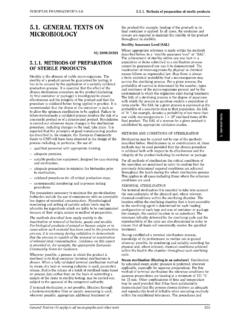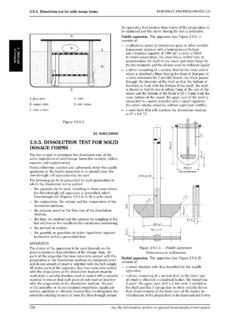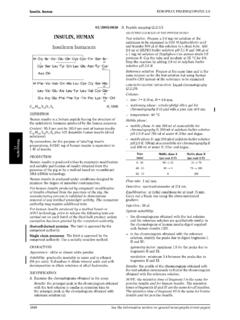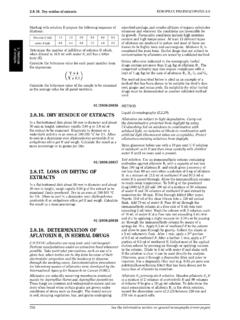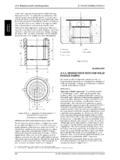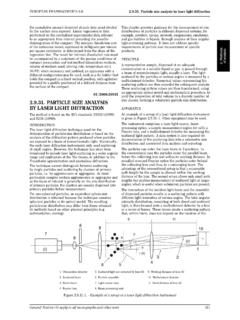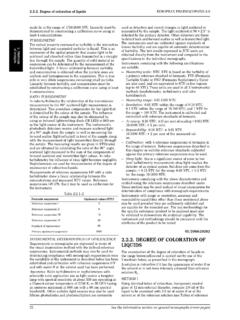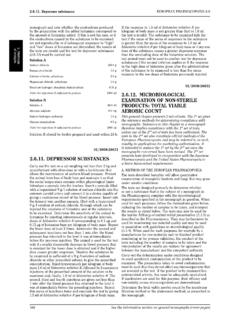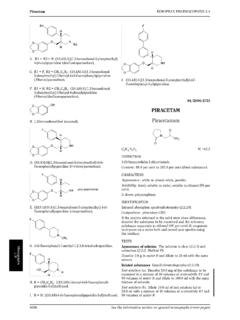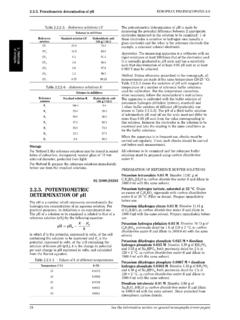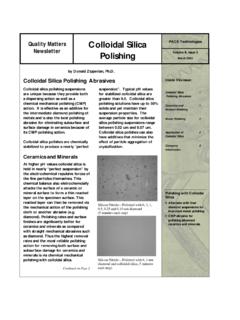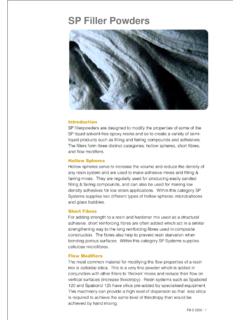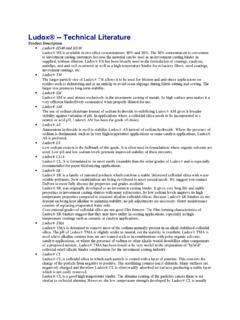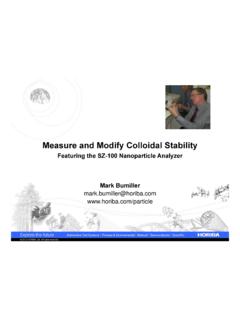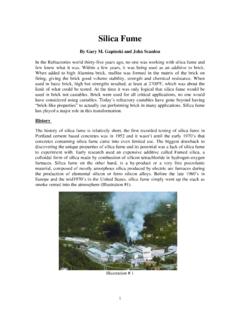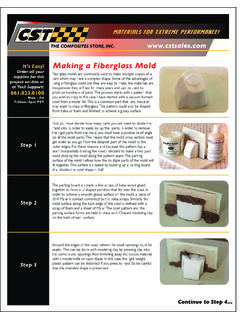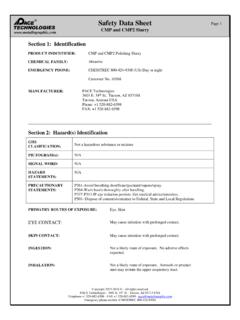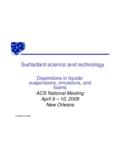Transcription of SILICA, COLLOIDAL ANHYDROUS SILICA, COLLOIDAL …
1 EUROPEAN PHARMACOPOEIA , COLLOIDAL hydrated01/2008:0434corrected , COLLOIDAL ANHYDROUSS ilica colloidalis [7631-86-9]DEFINITIONC olloidal ANHYDROUS silica contains not less than percent and not more than the equivalent of per cent ofSiO2, determined on the ignited light, fine, white or almost white, amorphous powder, witha particle size of about 15 nm, practically insoluble in waterand in mineral acids except hydrofluoric acid. It dissolves inhot solutions of alkali 20 mg gives the reaction of silicates ( ).TESTSpH( ). Shake g with 30 ml ofcarbon dioxide-freewater R. The pH of the suspension is to ( ). acid Rand 30 ml ofwater Rand heat on a water-bathfor 15 min, shaking frequently. Dilute to 50 ml withwater Rif necessary, filter and cool. 10 ml of the filtrate diluted to15 ml withwater Rcomplies with the limit test for chlorides(250 ppm).Heavy metals( ).
2 Suspend g in sufficientwater Rtoproduce a semi-fluid slurry. Dry at 140 C. When the driedsubstance is white, break up the mass with a glass rod. Add25 ml of1 M hydrochloric acidand boil gently for 5 min,stirring frequently with the glass rod. Centrifuge for 20 minand filter the supernatant liquid through a membrane acid Rand 9 ml ofwater Rand boil. Centrifugefor 20 min and filter the supernatant liquid through the samemembrane filter. Wash the residue with small quantities ofwater R, combine the filtrates and washings and dilute to50 ml withwater acid Rand 1 ml ofconcentrated ammonia withdilute ammonia R2. Dilute to 25 ml withwater R. 12 ml of the solution complies with limit test A forheavy metals (25 ppm). Prepare the standard usingleadstandard solution (1 ppm Pb) on ignition. Not more than per cent, determined g by ignition in a platinum crucible at 900 50 C for2 h.
3 Allow to cool in a desiccator before the residue obtained in the test for loss on ignitionadd ml ofsulphuric acid Rand sufficientalcohol Rtomoisten the residue completely. Add 6 ml ofhydrofluoricacid Rand evaporate to dryness on a hot-plate at 95 Cto 105 C, taking care to avoid loss from sputtering. Washdown the sides of the dish with 6 ml ofhydrofluoric acid Rand evaporate to dryness. Ignite at 900 50 C, allow tocool in a desiccator and difference between the mass of the final residue and themass of the residue obtained in the test for loss on ignitiongives the amount of SiO2in the quantity of the substanceto be examined :0738corrected , COLLOIDAL HYDRATEDS ilica colloidalis hydrica[63231-67-4]DEFINITIONC olloidal hydrated silica contains not less than per centand not more than the equivalent of per cent of SiO2( ), determined on the ignited white or almost white, light, fine, amorphous powder,practically insoluble in water and in mineral acids, with theexception of hydrofluoric acid.
4 It dissolves in hot solutionsof alkali About 20 mg gives the reaction of silicates ( ).B. When heated in an oven at 100 C to 105 C for 2 h, itshows a loss of mass not less than per acid Randmix. Heat on a water-bath for 30 min, stirring from timeto time. Maintain the original volume by addingdilutehydrochloric acid R. Evaporate to dryness. Add to theresidueamixtureof8mlofdilute hydrochloric acid Rand24 ml ofwater R. Heat to boiling and filter under reducedpressure through a sintered-glass filter (16) ( ). Washthe residue on the filter with a hot mixture of 3 ml ofdilutehydrochloric acid Rand 9 ml ofwater ofwater R,combinethefiltrateandwashingsanddilute to 50 ml withwater ( ). Suspend g in 30 ml of a 75 g/l solution ofpotassium chloride R. The pH of the suspension is to capacity. In a mortar, triturate 5 g with5mlofwater R, added drop by drop.
5 The mixture soluble in hydrochloric , evaporate to dryness ml of solution S and dry toconstant mass at 100 C to 105 C. The mass of the residueisnotmorethan10mg( ).Chlorides( ). Heat g with 50 ml ofwater Ron awater-bath for 15 min. Dilute to 100 ml withwater Randcentrifuge at 1500gfor 5 min. 10 ml of the supernatantsolution diluted to 15 ml withwater Rcomplies with thelimit test for chlorides ( per cent).Sulphates( ). Dilute 2 ml of solution S to 100 ml withdistilled water R. 15 ml of the solution complies with thelimittestforsulphates(1percent).Iron( ).To2mlofsolutionSadd28mlofwater ml of the solution complies with the limit test for iron(300 ppm).Heavy metals( ). To 20 ml of solution S add 50 mg ofhydroxylamine hydrochloride Rand 1 ml ofconcentratedammonia R. Adjust to pH by addingdilute ammonia R2,monitoring the pH potentiometrically. Dilute to 25 ml withwater R.
6 12 ml of the solution complies with limit test A forheavy metals (25 ppm). Prepare the standard usingleadstandard solution (1 ppm Pb) (1)applytoallmonographsandothertexts2877 silica , dental typeEUROPEAN PHARMACOPOEIA on ignition. Not more than per cent, determinedon g in a platinum crucible by heating at 100 C to105 Cfor1handthenat900 50 the residue obtained in the test for loss on ignition ml ofsulphuric acid Rand a quantity ofalcohol Rsufficient to moisten the residue completely. Add 6 ml ofhydrofluoric acid Rand evaporate to dryness at 95 C to105 C, taking care to avoid loss from sputtering. Washtheinsideofthedishwith6mlofhydrofluo ric acid Randevaporate to dryness again. Ignite at 900 50 C, allow tocool in a desiccator and weigh. The difference between themass of the final residue and that of the mass obtained inthe test for loss on ignition corresponds to the mass of SiO2in the test :1562corrected , DENTAL TYPES ilica ad usum dentalemDEFINITIONA morphous silica (precipitated, gel or obtained by flamehydrolysis).
7 Content: per cent to per cent of SiO2(ignitedsubstance).CHARACTERSA ppearance:white or almost white, light, fine : practically insoluble in water and in mineralacids. It dissolves in hydrofluoric acid and hot solutions ofalkali 20 mg gives the reaction of silicates ( ).TESTSS olution acid Randmix. Heat on a water-bath for 30 min, stirring from time totime. Evaporate to dryness. Add to the residue a mixture of8mlofdilute hydrochloric acid Rand 24 ml ofwater to boiling and filter under reduced pressure througha sintered-glass filter (16) ( ). Wash the residue on thefilter with a hot mixture of 3 ml ofdilute hydrochloric acid Rand 9 ml ofwater R,combine the washings and the filtrate, then dilute to 50 mlwithwater ( ): to 5 g in a mixture of 5 ml of a g/l solution ofpotassium chloride Rand 90 ml ofcarbon dioxide-freewater ( ) as described inthe test for time: chlorides = about 4 : chlorides: not more than the area of the correspondingpeak in the chromatogram obtained with the referencesolution ( per cent).
8 Sulphates. Liquid chromatography ( ).Test 30 ml ofwater Rand boil for 2 h. Allow to cool andquantitatively transfer to a 50 ml graduated flask. Dilute ml withwater ml withwater Rand filter through a membrane filter(nominal pore size m).Reference solution. Dissolve g ofanhydrous sodiumsulphate Rand g ofsodium chloride Rinwater Rand dilute to ml withwater R. Dilute ml of thissolution to ml withwater : material:non-metallic; size:l= , = ; stationary phase:suitableanion-exchangeresin(30-50 m).Mobile phase: dissolve g ofsodium carbonate g ofsodium hydrogen carbonate Rinwater R,thendilute to 1000 ml with the same : conductivity :25 time:sulphates= : sulphates: not more than the area of the correspondingpeak in the chromatogram obtained with the referencesolution ( per cent, expressed as sodium sulphate).Iron( ): maximum 400 2 ml of solution S to 40 ml withwater metals( ): maximum 25 20 ml of solution S, add 50 mg ofhydroxylaminehydrochloride Rand 1 ml ofconcentrated ammonia to pH by addingdilute ammonia R2, monitoringthe pH potentiometrically.
9 Dilute to 25 ml withwater ml of the solution complies with test A. Prepare thereference solution usinglead standard solution (1 ppmPb) on ignition: maximum per cent, determined g in a platinum crucible by heating at 100-105 C for1handthenat1000 50 the residue obtained in the test for loss on ignition ml ofsulphuric acid Rand a quantity ofethanol (96 percent) Rsufficient to moisten the residue completely. Add6mlofhydrofluoric acid Rand evaporate to dryness at95-105 C, taking care to avoid loss from sputtering. Washthe inside of the crucible with 6 ml ofhydrofluoric acid 50 C,allowto cool in a desiccator and weigh. The difference betweenthe mass of the final residue and that of the mass obtainedin the test for loss on ignition corresponds to the mass ofSiO2in the test :2208corrected , HYDROPHOBIC COLLOIDALS ilica hydrophobica colloidalisDEFINITIONC olloidal silicon dioxide partly alkylated for : per cent to per cent SiO2(ignitedsubstance).
10 CHARACTERSA ppearance: light, fine, white or almost white, amorphouspowder, not wettable by the information section on general monographs (cover pages)
